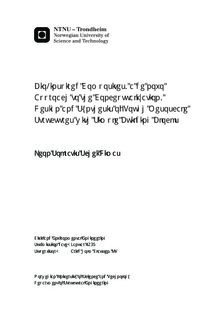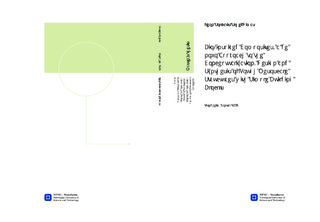| dc.contributor.advisor | Clausen, Arild Holm | nb_NO |
| dc.contributor.author | Dimas, Leon Sokratis Schei | nb_NO |
| dc.date.accessioned | 2014-12-19T12:01:47Z | |
| dc.date.available | 2014-12-19T12:01:47Z | |
| dc.date.created | 2013-04-21 | nb_NO |
| dc.date.issued | 2013 | nb_NO |
| dc.identifier | 617040 | nb_NO |
| dc.identifier | ntnudaim:8725 | nb_NO |
| dc.identifier.uri | http://hdl.handle.net/11250/237172 | |
| dc.description.abstract | Composites play an important role as structural materials in a range of engineering fields due to their potential to combine the best mechanical properties of their constituents. In biology, composites are ubiquitous and exhibit fascinating and precise architectures at fine length scales, where bone, hexactinellid sponges and nacreous abalone shells are prime examples. By learning from nature a de novo approach is applied leading to the synthesis of bio-inspired tough composites with simple building blocks. Fundamental design principles employed by nature in the assembly of mineralized composites are elucidated with simple mesoscale discrete lattice models. Computational investigations show that specific topological arrangements of soft and stiff phases in composites can markedly change the stress and strain transfer through a system, thus fundamentally changing their fracture mechanical behavior. Indeed, architectures are created from brittle building blocks that exhibit stable fracture propagation under sustained load transfer and increasing deformation. Furthermore, a detailed study of the basic interactions between constituents phases in a composite lead to fundamental insights of elastic interactions and stiffness ratios as controlling elements of the fracture mechanical behavior of composite systems. Tuning the linear elastic constitutive behavior of the matrix phase in a bone-like topology creates a set of composites spanning a wide area of toughness vs. stiffness in the Ashby plot. One specific composite system, designed at ‘minimal cost’, exhibits a fracture toughness modulus eight times larger than its constituents while retaining over 80% of the Young’s modulus of its stiffest phase. Finally the insights gained from the computational investigations are used as input in a design process resulting in 3D printed bio-inspired composite specimens. Utilizing multi-material 3D printing with structural features at micrometer length scales composites are printed with toughness moduli an order of magnitude larger than their building blocks. A computational model capable of predicting the experimentally observed mechanisms and trends in mechanical behavior is also produced. The research presents exciting outlooks for the future design of tough, structurally robust bio-inspired materials with applications in a wide range of engineering disciplines. | nb_NO |
| dc.language | eng | nb_NO |
| dc.publisher | Institutt for konstruksjonsteknikk | nb_NO |
| dc.title | Bio-inspired Composites, a de novo Approach to the Conceptualization, Design and Synthesis of Tough Mesoscale Structures with Simple Building Blocks | nb_NO |
| dc.type | Master thesis | nb_NO |
| dc.source.pagenumber | 114 | nb_NO |
| dc.contributor.department | Norges teknisk-naturvitenskapelige universitet, Fakultet for ingeniørvitenskap og teknologi, Institutt for konstruksjonsteknikk | nb_NO |

